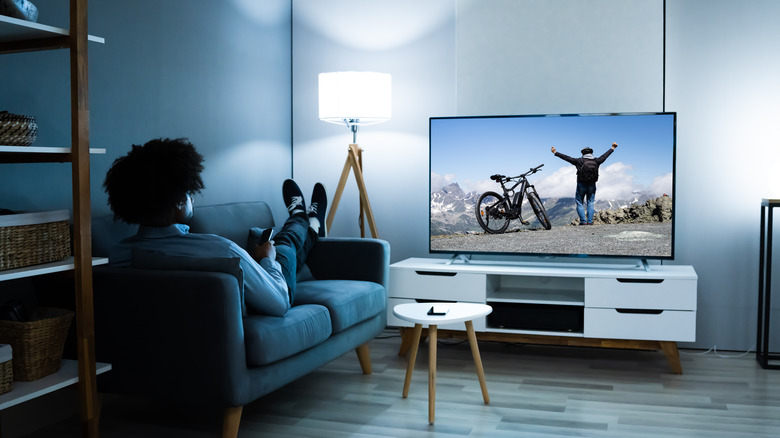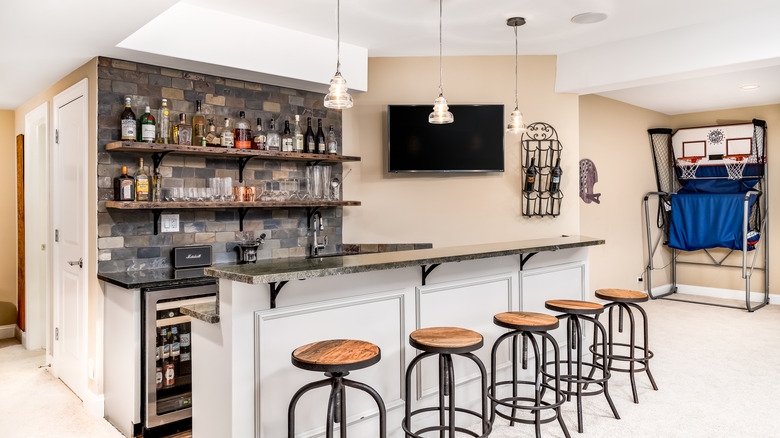How Much Does It Cost To Build An Entertainment Room From Scratch
Real Homes calls a home theater one of the most sought-after additions to a luxury home, and Forbes offers up a plethora of ideas for creating the ultimate gaming space to support the hobbies of your family. Homeowners everywhere are looking to incorporate a meaningful transformation into their properties in order to enhance the utility and value of their homes.
The Lived-in Look provides a guide to reimagining the entertainment equipment in your living room for around $1,000, but for those who are serious about engineering a real evolution in the way they spend down time and enjoy their home's entertainment amenities, a true entertainment room, built from scratch, is the only way to go. HomeAdvisor estimates a budget of anywhere from $3,000 to around $34,000, depending on the work involved in creating this addition to your home's footprint.
In the end, it all comes down to the particulars of the renovation. Adding a completely new room to the floorplan will boost the overall cost of the project but dramatically improve upon the home's total cash value (ranging from $80 to $200 per square foot and between $20,764 and $73,104 as a typical price range, via HomeAdvisor). Alternatively, finishing a basement, morphing an existing room, or transforming a garage to conform with your vision for a new entertainment space can provide a faster timeline and lower overall cost.
Factors for cost
From the fabrication of new interior or exterior walls to the wiring requirements and finishing touches, building a new entertainment room can be as in-depth a process as you want to make it. Crafting this kind of space is a uniquely personal endeavor, and it often begins with a somewhat lengthy planning phase in order to capitalize on all the precision elements that will make the finished product perfect for you and your family.
Room design plays a prominent role in the overall cost of construction
Designing the room's dimensions and inclusions is the first and most important step to creating this novel space in any home. This part of the home can be created with any sort of dimension in mind, but it's important to think through the number of individuals that will typically make use of the space together and account for the comfort and roominess that might support this number.
Doorways Magazine reports that the average U.S. bedroom measures 11 feet by 12 feet for a total area of 132 square feet. For many homeowners, transitioning an unused bedroom into this type of communal gathering space might be the perfect opportunity to repurpose a part of your home while cutting costs dramatically.
Alternatively, many homeowners want to add floor space to their property with each new renovation rather than simply creating an evolution in the home's current space. Adding a new room gives you the ability to craft a bedroom-sized space that can be made into a guest room or additional bedroom in the event of a sale. It also provides the option to design a larger floor space that will be crafted into a customized, luxury entertainment suite that's perfect for elevating your property to a new status.
Electrical wiring and comfort systems must be installed for maximum enjoyment
Hiring an electrician is a crucial component of getting your dedicated entertainment space up and running. Forbes Advisor reports that the typical cost of professional electrical services ranges from $50 to $100 per hour, not including potential travel fees, material costs, and other charges. But hiring an electrician to wire the room is an unavoidable reality. Homeowners simply lack the expertise and safety knowledge to effectively carry out this task.
You may also consider bringing on an electrician to install consumer electronics rather than approaching the task yourself. This prevents you from having to crawl around into tight corners or even up into the attic to ensure a seamless fit across the expanse of the new entertainment room.
Entertainment rooms can take on many forms, but often include state-of-the-art media systems
The most basic footprint that can make an immediate splash in your home is the simple media center design. Whether you're repurposing an existing device in your home (like an unused tower desktop or a Raspberry Pi 3, as per this Tech Hive article) or building a completely new entertainment center in an existing living room or other space in the home, technology and great gear rule the day.
A basic media playback solution requires audio and video equipment, but it will also require storage and transmission installations that provide powerful solutions to the problems you're trying to solve: Namely, the ability to queue up any type of media that a moment calls for. A home media center is the perfect application for a homeowner seeking a simple transformation in their viewing and entertainment habits that removes the clunky and expensive infrastructure of cable or satellite television contracts and hookups (via Make Use Of).
A simple locally wired machine (costing between $700 and $800, via Lifewire) or a NAS device (from around $200 to about $600, according to The New York Times' Wirecutter) that incorporates seamless cloud storage access or expansive local hard drive storage (via LifeHacker) can make all the difference when building out your entertainment system.
Additional costs
In addition to the basics of the build, many homeowners select further features to round out the style and functionality of the new space.
Food and drink inclusions can elevate the space but will cost extra
For a larger project space, you might consider adding a fridge, basic cooking equipment (or perhaps just a simple microwave to accommodate for popcorn and other snacks), and even a bar. These additions can make the entertainment space a far more luxurious area to relax in but will cost you extra. HomeAdvisor estimates the total cost of a home bar at $8,000, on average, but this can be scaled down or ramped up in meaningful ways, depending on the particulars and nuanced details of the build.
Engineering the space with the future in mind is crucial to getting the most bang for your buck
Entertainment rooms often evolve over the years. For instance, avid golfers may think about installing a simulator platform in this space to allow for indoor driving or chipping practice. Play Better recommends a minimum ceiling height for this amenity at 8.5 feet; however, a 10-foot swing allowance provides a much more comfortable experience.
Similarly, as tastes change, an entertainment space can evolve from a dedicated sports and movies screening space to one that incorporates a pool or poker table, computer gaming, or a fleet of console gaming chairs (like these recommended by High Ground Gaming) that make Xbox or PlayStation sessions all the more enjoyable. Thinking through these changes in potential space requirements as you plan out the initial design will help make this room a unique and rewarding feature of your home for many years to come.
Furniture should factor heavily into the layout of the space
The last thing that many homeowners add to a new entertainment room is furniture. However, it's important to think about these inclusions well before the closing phases of construction. For the most part, a modern entertainment room will make prominent use of a television screen, and with this technology comes the need to secure the screen either to a wall or with the help of a TV stand that can provide a stylish and utilitarian focal point (browse a few great ideas for TV stands from The Spruce).
The mounting options for your television can help direct the remainder of the space's decorative style and overall layout. Matching wood tones, color palates, or themes is easier once you've settled on a primary piece that can tie the room together. Today, televisions act as the central point of focus in any living room or entertainment space. Nielsen estimates that 96.2% of U.S. households have at least one television and the corresponding video playback capacity required for viewing (traditional antenna connections, cable, DBS, or broadband streaming). This indicates that TV viewing is an important component of the entertainment and relaxation time happening in nearly all American homes, so starting with the television and required mounting and storage furniture is a great way to make sense of the theme in the remainder of the room.
Adding couches, lounge chairs, and table space will round out the entertainment room nicely, but it's important to understand the role of these fixtures in the budget. According to Curbed, the average consumer pays around $1,000 for a new sofa, and the longevity of this furniture staple is often linked directly to the price tag as a result of slim profit margins for the manufacturer. The bottom line, says Curbed and nearly any other resource for furniture shopping: Make sure you purchase the best couch you can afford for the greatest timeline of use.
Decorations bring the finishing touches to a new game room or home theater
Finally, it's essential to target decoration options as you finalize the room's outline and style. With an interior designer's help, you can expect to pay $50 to $200 an hour for the consultation, plus the cost of furniture and decorations (via HomeGuide). However, many homeowners opt to go it alone when it comes to adding their own finishing touches and style elements to this space.
Bark reports that it will cost an average of $300 to $800 for full room painting and decorating, but this can vary based on the style that you select. For instance, a game room that leans into the favorite movie and game titles of the family might choose to incorporate a customized mural that features favorite characters, while a sports fanatic may want to add memorabilia from their favorite teams to the walls of the new room.
Types of home entertainment facilities
Creating a home entertainment room can be done with a number of specialized purposes in mind. Whether you're thinking of riffing off of one of the most popular options out there or designing your own unique space, the typical layouts often follow many of the same patterns.
The man cave
The man cave is a quintessential blueprint for home entertainment rooms. Initially, this was conceived of as a space for men to get away from the stressors of modern life, but in the present, this form can be used as a means of creating a vibrant relaxation space for any member of the family — not just the men.
A traditional man cave, according to Man Cave Know How, caters to the personalized needs of the home's male inhabitant(s). Taking this cue, an entertainment room that's built in the style of a man cave will often incorporate many of the family's favorite things, activities, and belongings.
Mymove.com reports that a man cave is a great addition to any home in which the owners often invite friends over for parties or other gatherings. These spaces can be built in the image of a bar area, game room, or home music studio, and entertaining in the room takes on the energy of the included features and amenities.
The retro arcade
Those who love arcade games and other, similar forms of entertainment will benefit greatly from the inclusion of a game-centric entertainment room. The Geek Pub provides a crash course for anyone thinking of building their own arcade game cabinet and interior computer unit to run game programs. Homeowners that have a love of these kinds of entertainment throwbacks can opt to create a single game cabinet that can run all their favorite titles. Alternatively, they can even construct a complete set of working game cabinets themselves that make use of game emulator technology (via Help Desk Geek) to provide a realistic experience that brings users right back to the heart of the arcade frenzy.
Purchasing a few arcade machines rather than building your own can give your entertainment room a different kind of feel as well. Game and Entertain estimates that the price of a standard machine ranges from about $500 to $5,000, depending on the title, with classic games that are no longer in production — like Pacman or Space Invaders — starting at around $3,000. For any authentic machine, popularity, age, and overall condition will each play a major role in the asking price that a seller might place on the unit.
The home theater
Nowadays, the desire to incorporate this kind of amenity into the home has risen sharply (via Bloomberg). A home theater is at its best when utilizing a projector screen and surround sound installations for a true theater atmosphere that magnifies the grandness and energy of any movie. There's a reason that 1.24 billion movie tickets were sold across North America in 2017, according to Movie Guide, and why so much focus has been placed on consumer moviegoing habits throughout the shuttering of theaters during the pandemic (via Forbes).
Creating a home theater is actually pretty easy. The Verge reports that a high-quality screen can be attained for around $100, and a projector that does your movie selections justice can range from around $530 to $2,800. Angi points out that surround sound installations average $665 and range from $245 to $1,120.
The family activity hub
Lastly, a home entertainment room can serve as a high-tech space for enjoying media, alone time, and more; but one great avenue to pursue is the family hub. Spending time with loved ones is a noble pursuit, and building a central entertainment space that can facilitate more time spent together (specifically, time spent actively engaged with one another) is a fantastic option for any home.
Quartz reports that the number of screens available to the typical media consumer has risen in recent years, making for a stark rise in what is dubbed as time spent alone-together. Many families have made a habit of watching television together in the evenings, but with the introduction of personal cellular devices and tablets, even this time spent consuming media together is beginning to fray.
A family-centric entertainment space can change this. Making the focal point a customized game table or adding unique installations that can support the hobbies and interests of each member of the family can make for a more enjoyable evening spent in the company of loved ones rather than silently consuming personal media while ignoring others in close proximity.
Why you need an entertainment room in your home
Adding an entertainment space that's dedicated to your unique personality and interests is the perfect way to reimagine your home in a way that serves your lifestyle, needs, and overall happiness. According to Home Design Lover, an entertainment room is a unique addition to the home because it's the only room whose sole purpose is fun, enjoyment, relaxation, and of course, entertainment. Many homeowners might think that they gain this environment in a living room or family room, but the truth is that dedicating a particular space to entertainment and the kinds of things that you love to do as individuals or as a family can transform the way you envision your entire home.
An entertainment room houses the comfort and joy that you experience in your home
This space provides a blank slate for homeowners seeking to change the way they use their home. In the present climate, many property owners are looking for ways to ensure that continued COVID-related public health threats won't impose renewed hardship on their family and social connections.
Bloomberg reports a rise in new home buying through the pandemic and a shift in the way people are thinking about entertainment and at-home luxuries. Many of these evolutions in the way that people utilize their personal space are likely here to stay, and home entertainment rooms have become a popular choice among those seeking an alternative to potentially risky social gatherings in movie theaters, bars and restaurants, and elsewhere. Bringing these creature comforts and fun atmospheres directly into the home is the aim of a new entertainment room build, and for many homeowners, this is being achieved with great success.
Benefits of a new home entertainment space
An entertainment room is a fantastic addition to the floorplan of nearly any home. Adding a dedicated space to unwind at the end of the day, or to spend hours enjoying your family's favorite things throughout the weekend, can add immense value to the property and provide a foundation for incredible memories with loved ones.
These spaces allow for unlimited imagination and customization while maintaining a core asset that boosts financial value
A specialized benefit of any home addition is the added value that a new space or an upgraded room can provide. Whether you're altering an adult child's bedroom to incorporate new entertainment features or building an extension to account for the new area of the home, these additions can really improve upon the resale value of your property. If done intelligently, Projector Screen estimates a return on investment of around 65% for a home theater addition. Troost Bros suggest that an extension can net a return of 50% to 83% and recommend game rooms as a staple installation for these added spaces.
Entertainment rooms offer countless hours of fun
Housing.com reports that the concept of entertainment in the home has evolved in recent years and with it, the DNA of the home itself. With countless volumes of inspiration on Pinterest and beyond, finding a setup that can facilitate your family's hobbies and boost the home's value is easier than ever.
Today, at-home entertainment rooms incorporate lounge spaces, food and drink amenities, games, and recreational equipment like pool tables, ping pong tables, and poker equipment, and the possibilities don't end there. The sky is the limit when it comes to designing the perfect entertainment space to suit your family's interests and unique needs. Small and large entertainment spaces alike can transform the look and feel of your home, providing you with a fantastic new area to enjoy all your favorite activities.





